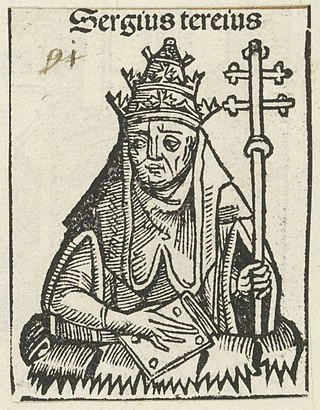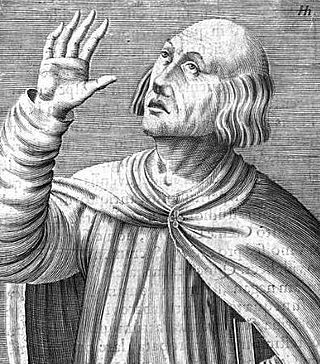
Pope Agapetus II was the bishop of Rome and ruler of the Papal States from 10 May 946 to his death. A nominee of the princeps of Rome, Alberic II of Spoleto, his pontificate occurred during the period known as the Saeculum obscurum.

Pope Urban II, otherwise known as Odo of Châtillon or Otho de Lagery, was the head of the Catholic Church and ruler of the Papal States from 12 March 1088 to his death. He is best known for convening the Council of Clermont which ignited the series of Christian conquests known as the Crusades. When the First Crusade was launched, Pope Urban II was 60 years old. Pope Urban was a native of France, and was a descendant of a noble family from the French commune of Châtillon-sur-Marne. Reims was the nearby cathedral school where he began his studies in 1050.

Pope Sergius III was the bishop of Rome and nominal ruler of the Papal States from 29 January 904 to his death. He was pope during a period of violence and disorder in central Italy, when warring aristocratic factions sought to use the material and military resources of the papacy. At the behest of Theophylact I of Tusculum, Sergius seized the papal throne from Antipope Christopher, who in turn had deposed Pope Leo V. Sergius' reign was subsequently marked by Theophylact's influence. As pope, Sergius continued many ecclesiastical controversies of his predecessors, including conflict over Pope Formosus' legacy, annulling all ordinations made by the late pope, and the filioque controversy with eastern patriarchs. His pontificate was similarly marked by temporal conflicts, with Sergius' refusal to crown Berengar I of Italy as Holy Roman Emperor, and his support of Byzantine Emperor Leo VI the Wise's fourth marriage. Sergius also saw the restoration of the Lateran Palace.

Pope Victor III, was the head of the Catholic Church and ruler of the Papal States from 24 May 1086 to his death. He was the successor of Pope Gregory VII, yet his pontificate is far less notable than his time as Desiderius, the great abbot of Montecassino.

Year 1061 (MLXI) was a common year starting on Monday of the Julian calendar.
The 1080s was a decade of the Julian Calendar which began on January 1, 1080, and ended on December 31, 1089.

Pope Gregory VII, born Hildebrand of Sovana, was head of the Catholic Church and ruler of the Papal States from 22 April 1073 to his death in 1085. He is venerated as a saint in the Catholic Church.

Berengar of Tours, in Latin Berengarius Turonensis, was an 11th-century French Christian theologian and archdeacon of Angers, a scholar whose leadership of the cathedral school at Chartres set an example of intellectual inquiry through the revived tools of dialectic that was soon followed at cathedral schools of Laon and Paris. Berengar of Tours was distinguished from mainline Catholic theology by two views: his assertion of the supremacy of Scripture and his denial of transubstantiation.

Robert "Guiscard" de Hauteville, sometimes Robert "the Guiscard", also nicknamed “Terror Mundi”, was a Norman adventurer remembered for his conquest of southern Italy and Sicily in the 11th century.
Pope John X was the bishop of Rome and nominal ruler of the Papal States from March 914 to his death. A candidate of the counts of Tusculum, he attempted to unify Italy under the leadership of Berengar of Friuli, and was instrumental in the defeat of the Saracens at the Battle of Garigliano. He eventually fell out with Marozia, who had him deposed, imprisoned, and finally murdered. John’s pontificate occurred during the period known as the Saeculum obscurum.
Berengar is a masculine name derived from Germanic roots meaning "bear" and "spear". The name appears frequently among certain noble families during the Middle Ages, especially the Unruochings and those related. Bérenger is the French form, while Berengario is the Italian form, Berenguer is the Catalan form, and Berenguier or Berengier is the Occitan form. The Latin form is Berengarius and the female equivalent is Berengaria. Other forms of the name include Berenger, Bérenger, Bérangier, or Beringer.
Richard Drengot was the count of Aversa (1049–1078), prince of Capua and duke of Gaeta (1064–1078).
William of Hauteville was one of the younger sons of Tancred of Hauteville by his second wife Fressenda. He is usually called Willermus instead of Wilelmus in Latin annals and so is often called Guillerm instead of Guillaume in French.
Cencio I Frangipane was a Roman nobleman of the Frangipani family of the latter half of the eleventh century. He was a Roman consul
Robert de Grantmesnil also known as Robert II, was a Norman nobleman; a member of a prominent Norman family. He first became a monk, then abbot at the Abbey of Saint-Evroul in Normandy and later Bishop of Troina in the Norman Kingdom of Sicily.

Berengar Fredol or Bérenger Frédol was a French canon lawyer and Cardinal-Bishop of Frascati.
Henry was the Count of Monte Sant'Angelo, with his seat at Foggia, from November 1081.
The Abbey of Saint-Evroul or Saint-Evroul-sur-Ouche is a former Benedictine abbey in Normandy, located in the present commune of Saint-Evroult-Notre-Dame-du-Bois, Orne, Normandy. It has been classified as a historical monument since 1967. Its name refers to its founder, Ebrulf (Evroul), who founded a hermitage in the forest of Ouche around 560. The abbey was rebuilt around 1000.
The Italian Catholic diocese of Venosa, in southern Italy, existed until 1986. In that year it was united into the Diocese of Melfi-Rapolla-Venosa. From 1976 to 1986, Venosa had been a suffragan of the archdiocese of Potenza e Marsico Nuovo.
Aimery I of Narbonne, son of Bernard Berenger of Narbonne and Foy of Rouergue. He was viscount of Narbonne 1071 until his death in the Holy Land in 1106.